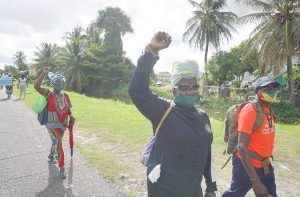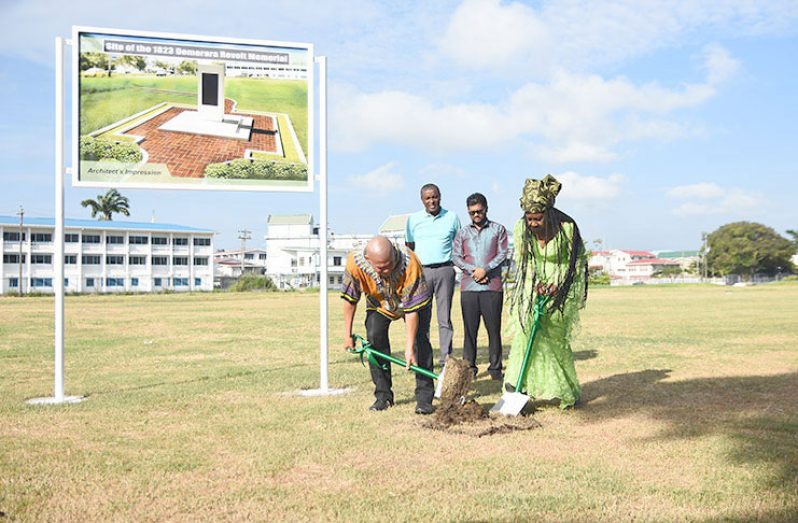A SMALL group of Afro-Guyanese from the Coalition for the 1823 Monument, despite the challenges of the COVID-19 pandemic, participated in the annual Remembrance Walk from Le Resouvenir on the East Coast Demerara (ECD) to Parade Ground in memory of the 1823 martyrs.

The oldest person taking the journey was President of the Ghana Day Organisation, Sister Penda Guyan. Amidst the sounds of drum beating, she told the Guyana Chronicle of the motivation behind the walk and what it signifies. Guyan first shared that the 1823 revolution was the continuation of the 1763 uprising — an organised revolt which was later known as the Berbice Slave Rebellion.
On August 18, 1823, a two-day uprising of over 10,000 enslaved Africans, led by those of the highest status amongst them, took place in the Crown Colony of Demerara-Essequibo. The enslaved Africans were fuelled mainly by poor treatment and the deliberate withholding of information by the planters on England’s orders that immediate and effective measures be taken for the abolition of slavery throughout the British colonies.
The rebellion was deemed largely non-violent as the enslaved Africans tied up the whites, relieving them of their weapons and ammunition. Guyan said that the 1823 revolution was one of the biggest in the region, at that time. It was chiefly instigated by Jack Gladstone, a slave at the Success plantation; his father, Quamina Gladstone, and other senior members of their church group, the Bethel Chapel of the London Missionary Society. However, on August 20, 1823, the Africans were defeated by the colonial cavalry, and over 200 were killed. Following the rebellion, the government sentenced another 45 men to death and 27 were executed.
Many heads were placed on spikes and dead bodies were publicly displayed at what is now known as Parade Ground, which originally stretched from New Market Street to Quamina Street. It served as a means to discourage other enslaved Africans from rebelling against their masters. “They made them carry their own coffins all along Main Street into the Parade Ground where they were executed, the ring leaders. They gave them a mock trial and executed them,” Guyan said.

“Why we do the walk, is that we’re remembering the sacrifices that they made, the blueprint they left us. They left us an example of what we should do. So, every year we try to do a recreation of the steps that they took. We do this walk to see how it must have felt for our ancestors to have to do this bearing in mind they were in chains and shackles.”
In September 2019, members of the African community in Guyana were overjoyed that the sod was officially turned for the erection of an 1823 memorial in memory of those who lost their lives during the 1823 Demerara Rebellion. Guyan and others believe that placement of the monument at the ground acknowledges the right of those who brutally lost their lives to have their wandering spirits be laid to rest, knowing that the whole truth of the rebellion will be told.
During the walk, some members of the Coalition for the 1823 Monument used the occasion to protest against what they believe are the common-day injustices in Guyana. Their placards were specifically related to the ongoing elections and their call for authenticity to form the basis from which the result of the elections is declared.

Guyan said that, though the pandemic has forced many persons to remain indoors, she is pleased that some have decided to make the walk.




.png)









